Nobel Prize Winners Gather as Part
of Series of Signature Events to Celebrate Innovation
Ioana Patringenaru | Feb. 28, 2011
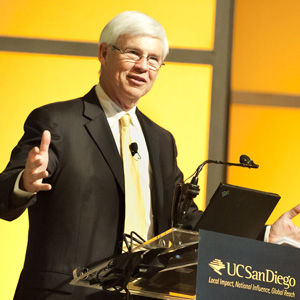
Economist Robert Engle talks about the work that earned his the Nobel Prize.
Photos/Erik Jepsen
One changed the way individuals and corporations invest. Another found a way to forecast volatility in the financial market. Another helped rid the world of harmful chemicals that were destroying the planet’s ozone layer. Yet another helped craft fluorescent proteins that allow scientists to peer into the mechanisms of life itself. All four received the Nobel Prize.
Harry Markowitz, Mario Molina and Roger Tsien, currently on the UC San Diego faculty, and Robert Engle, a professor emeritus, spoke about their breakthroughs and their life before and after the Nobel Prize Wednesday night at the Price Center. The three-hour talk was part of the campus’ Innovation Day Expo and Symposia, a series of signature events in this year’s 50th anniversary celebrations.
“As we strive to achieve excellence, we look up to these individuals who’ve been pioneers and broke barriers in their own field,” said Suresh Subramani, the acting senior vice chancellor of academic affairs
The importance of collaboration
During Wednesday’s talk, all four Nobel laureates emphasized the importance of cross-disciplinary collaboration. All either are affiliated with more than one department or have switched departments during their career. Tsien belongs both to the Division of Chemistry and Biochemistry and the Skaggs School of Pharmacy and Pharmaceutical Sciences. Molina is affiliated with chemistry and biochemistry and the Scripps Institution of Oceanography. Markowitz moved from the department of economics to the Rady School of Management. Engle went to New York University’s school of business after leaving UCSD.
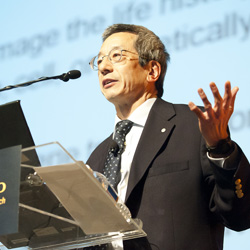
Biologist Roger Tsien received the Nobel Prize in chemistry in 2008 for his work on the green fluorescent protein.
All four researchers are outstanding colleagues in their departments, said Richard Attiyeh, professor emeritus of economics and moderator of Wednesday’s event. They also all became interested in science at an early age. Their biographies on the Nobel Prize website all mention chemistry sets and rocket launching kits acquired when they were in elementary school. The researchers also all share a love of music and play musical instruments. Tsien even picked Harvard over Caltech for his undergraduate studies because it had a better music department, Attiyeh said.
Crafting tools to investigate life
But it was his “love of pretty colors,” as Tsien puts it, that set him on the path that would eventually lead to the Nobel Prize. He took a cloned version of the green fluorescent protein, also known as GFP, produced by jellyfish, and improved it for scientific use. He also broadened GFP’s palette beyond blue and green to myriad colors by using bioluminescence produced in corals.
That work earned him the Nobel Prize, along with two other researchers. But he advised young scientists to pursue their passions rather than a quest for prizes. “You have to go for things that please your own gut,” he said.
More recently, Tsien has turned away from GFP, which cannot be injected in human beings due to ethical concerns. He is now working on fluorescent peptides to help researchers and physicians peer into the human body. He recently helped develop a substance that shows hidden nerves, assisting surgeons in avoiding damaging them during operations. Another substance makes cancerous cells glow and allows surgeons to easily tell how much tissue they need to remove.
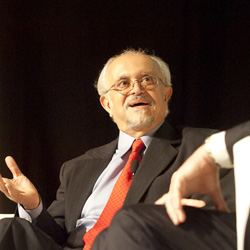
Mario Molina helped rid the world of chemicals that were destroying the Earth's ozone layer.
Working to ban harmful chemicals
Meanwhile, Molina helped tackle one of the most severe environmental problems the planet has faced. It took him two decades to do it. He and Sherwood Rowland, then at UC Irvine, were investigating the impact on the atmosphere of chlorofluorocarbons (CFCs), chemicals found in refrigerators and aerosol bottles at the time.
CFCs actually survive until they reach the Earth’s stratosphere, where the sun’s radiation finally destroys them. The two researchers hypothesized the chemicals’ byproducts then reacted with ozone molecules. “A single chlorine atom can destroy tens of thousands of ozone molecules,” Molina said.
Molina now had to prove his hypothesis was correct. It took two decades until atmospheric measurements and other tools proved him right. Governments then moved to ban the manufacturing of CFCs through a series of international agreements. Still, CFCs have a long life, so the Earth’s ozone layer won’t recover until mid-century, Molina said. His work allowed him to advocate for better science, he said.
The fight against CFCs offers a blueprint for effective solutions that could be applied to the fight against climate change, Molina said. But he also deplored the political rhetoric surrounding the issue. “You don’t have to be absolutely certain to make a decision,” he said.
Better tools to invest
Uncertainty of another kind was the focus of Markowitz’s work. The idea of diversifying investments is nothing new, he said Wednesday, quoting from both Shakespeare’s “Merchant of Venice” and Robert Louis Stevenson’s “Treasure Island” to make his point.
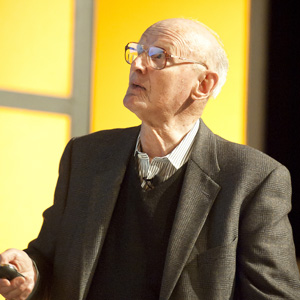
Economist Harry Markowitz explained how he crafted portfolio theory.
But before his ground-breaking work in the 1950s, there was no theoretical framework to analyze diversification. In fact, while Markowitz was defending his dissertation, Milton Friedman jokingly argued that portfolio theory was not economics. Markowitz developed the mathematical framework and applications behind the theory. He is proud of his Nobel, but he is prouder that his work gave birth to an investment industry that employs tens of thousands, he said.
Understanding unpredictable markets
Engle also developed statistical models that have become key tools of modern asset allocation theory and practice. He shared a Nobel Prize with fellow UCSD economist Clive W.J. Granger, who passed away in 2009. Engle’s most important contribution was the discovery of a method for analyzing unpredictable movements in financial market prices and interest rates. After his Nobel win, he decided to turn his attention to financial policies and practices, in an effort to continue making an impact, he said.
Both Engle and Markowitz defended their theories in the face of the recent financial market debacle. Portfolio theory only lays out a blueprint for trade-offs between risks and returns; it doesn’t eliminate risk, Markowitz said. Similarly, statistical models correctly predicted market volatility during the crisis, Engle said. But they’re only looking forward for a very short period of time, he added.
Engle said that new regulations enacted in Washington, D.C., would be effective to address the problems that created the crisis. But Markowitz sounded a cautious note. “The old problems are solved,” he said. “Give it a decade, and we’ll have new problems.”.
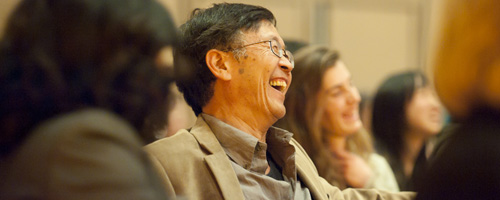
Jim Lin, a mathematics professor, reacts during the talk.

|